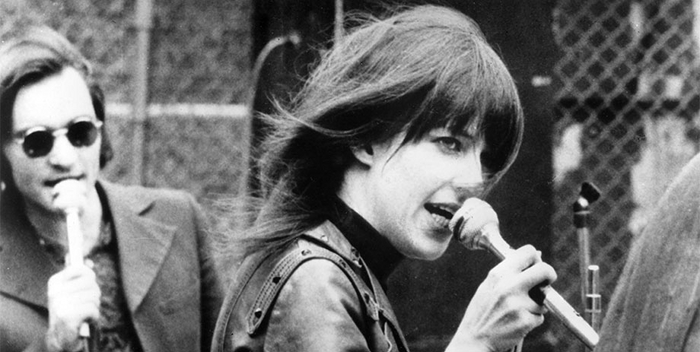
1 P.M. (1971)
Cast: Marty Balin, Amiri Baraka, Carol Bellamy
Directors: Jean-Luc Godard, Richard Leacock, D.A. Pennebaker
Country: USA
Genre: Documentary
Editor’s Notes: The following review is part of our coverage for TIFF’s Godard Forever: Part Two. For more information on upcoming TIFF film series visit http://tiff.net and follow TIFF on Twitter at @TIFF_NET.
1 P.M., also known as One Parallel Movie—or, according to Godard, One Pennebaker movie—is a reconstructed enactment of a film originally titled 1 A.M. (One American Movie). When Godard’s 1 A.M. was not fully realized, Pennebaker deconstructed Godard’s thematic intentions and recontextualized them in creating a meta-textual film about process. In particular, Godard’s process in creating 1 A.M. is documented and set beside film footage shot for 1 A.M., thus forming a blend of reality and artistry.
1 P.M. opens with an office discussion; Godard speaks to a group of filmmakers, film producers, and actors about his film, 1 A.M. He tells them the goals of the film, and directs them in how to make this movie. He expresses that he wants to create a unity between reality and fiction, and explains that there will be an A reality and a B reality. The film will comprise of five sections, wherein first a speech will be shown from its authentic source, and second the same speech will be performed by an actor. For example, he wishes to shoot the Wall Street Lady on Wall Street and follow this by shooting an actor giving the same speech in the fictional setting of a high school. Godard’s intention with 1 A.M. is to establish that reality is not truly separated by fiction and non-fiction— “reality is equal to art”.
When Godard’s 1 A.M. was not fully realized, Pennebaker deconstructed Godard’s thematic intentions and recontextualized them in creating a meta-textual film about process.
While 1 A.M. never came to be as intended, the ideas that motivated its making are certainly realized in 1 P.M. In a sense, the film thus resembles a later Iranian film entitled Close-Up (Kiarostami, 1990). By focusing on process, the motivations involved in the making of 1 A.M. are seen vis-à-vis its reconstruction in 1 P.M. In Close-Up, a film that too blurs the lines between document and fiction, Sabzian’s motivations behind impersonating his favourite director are realized by Kiarostami’s meta-textual film about Sabzian’s personality. Both films draw on the reality that is found in fiction; artifice is used to render document, which is no longer fiction or non-fiction, but a hybrid which ostensibly shares a greater truth than either form could have done individually.
Unlike Close-Up, however, which works on every level and displays an incredible amount of mastery and sophistication, 1 P.M. is a rather scattered cut-and-paste film with little thematic unity besides its meta-textual concept and the revolutionary thinking and speeches which inspired it. Though the speeches and music resonate amongst each other, the film’s fragmented design and presentation of individuals fail to form a coherent image, and thus do not fulfill their promise of expressing Godard’s original concept at large. This is not to say that the film does not work, but that it works differently, as a unique free-form film. 1 P.M. works as an intellectual art-essay-document of a collection of politically charged images and sounds in 60s California.
1 P.M. becomes a very different film from what Godard outset with 1 A.M., though there is one case where his sectional analysis of fiction and non-fiction is especially meaningful.
For example, while the Jefferson Airplane rooftop concert is amazing in its own right, it’s placement in the film is rather arbitrary. It seems as though the concert on the roof, which occurred before the Beatles famous rooftop concert, is presented simply because of how amazing the footage is. Without warrant, these young artists went on a roof and played music to wake up the streets of San Francisco. There is a connection here between Jefferson Airplane’s youthful freedom and Godard’s objective to show art as reality and artistry as revolutionary form, but the connection is quite tenuous and poorly executed in 1 P.M., since it appears as a fragmented, disconnected episode.
1 P.M. becomes a very different film from what Godard outset with 1 A.M., though there is one case where his sectional analysis of fiction and non-fiction is especially meaningful. An actor is shown in documentary form practicing the speech he is supposed to act. His act has now become a different kind of reality. We don’t see the actor but the man becoming an actor. He practices with a sense of performativity, thus channelling the artistry or fiction which will inspire his speechmaking. This in no way, however, removes him from reality; it is simply a reality of a different kind. It is not his own speech, but giving this speech is indeed his own reality. Acting, thus, is always still a form of reality.
Throughout the film we hear speeches from authentic sources, from actors, and from behind the scenes settings where actors are practicing. Ultimately, while the speeches themselves are worth hearing for their inspired ideas, the speeches no longer matter in 1 P.M. The focus has shifted from the speeches to the process of capturing the speeches instead. The process itself is of central importance. That the speeches remain present gives the viewer multiple versions of film, or multiple versions of reality. As such, a change in one’s attention alters one’s viewing practice and therefore one’s mode of perception. Reality and fiction, art and documentary intermingle in the consciousness of the viewer. 1 P.M. thus provides an unnatural experience, and this is precisely what Godard wished to illustrate by blending reality and fiction. For him, “art is not natural”. He wanted to do something different, and he did. With the help of Richard Leacock and DA Pennebaker, Godard made something truly unique, original, and unnatural, despite meandering out to the left field of 1 A.M.
1 P.M. provides an unnatural experience, and this is precisely what Godard wished to illustrate by blending reality and fiction.




